Assessment 1: BSBLDR801 Leading Personal and Strategic Transformation
VerifiedAdded on 2022/10/06
|14
|3536
|23
Homework Assignment
AI Summary
This assignment presents a student's responses to a comprehensive knowledge test on leadership, focusing on BSBLDR801. The questions cover key leadership concepts including situational, transactional, and transformational leadership styles. The student defines situational leadership, differentiates between transactional and transformational leadership, and explains the importance of transformational leadership in organizational functioning. Furthermore, the assignment explores the behaviors of transformational leaders, the concept of self-efficacy, and how leaders can enhance their personal effectiveness. It also outlines essential qualities of servant leadership, such as empathy, listening, and awareness, and discusses the impact of competencies on leadership roles. The assignment draws on research to support the answers and provides a thorough understanding of leadership principles and their practical application. This assignment is available on Desklib, a platform providing study resources for students.
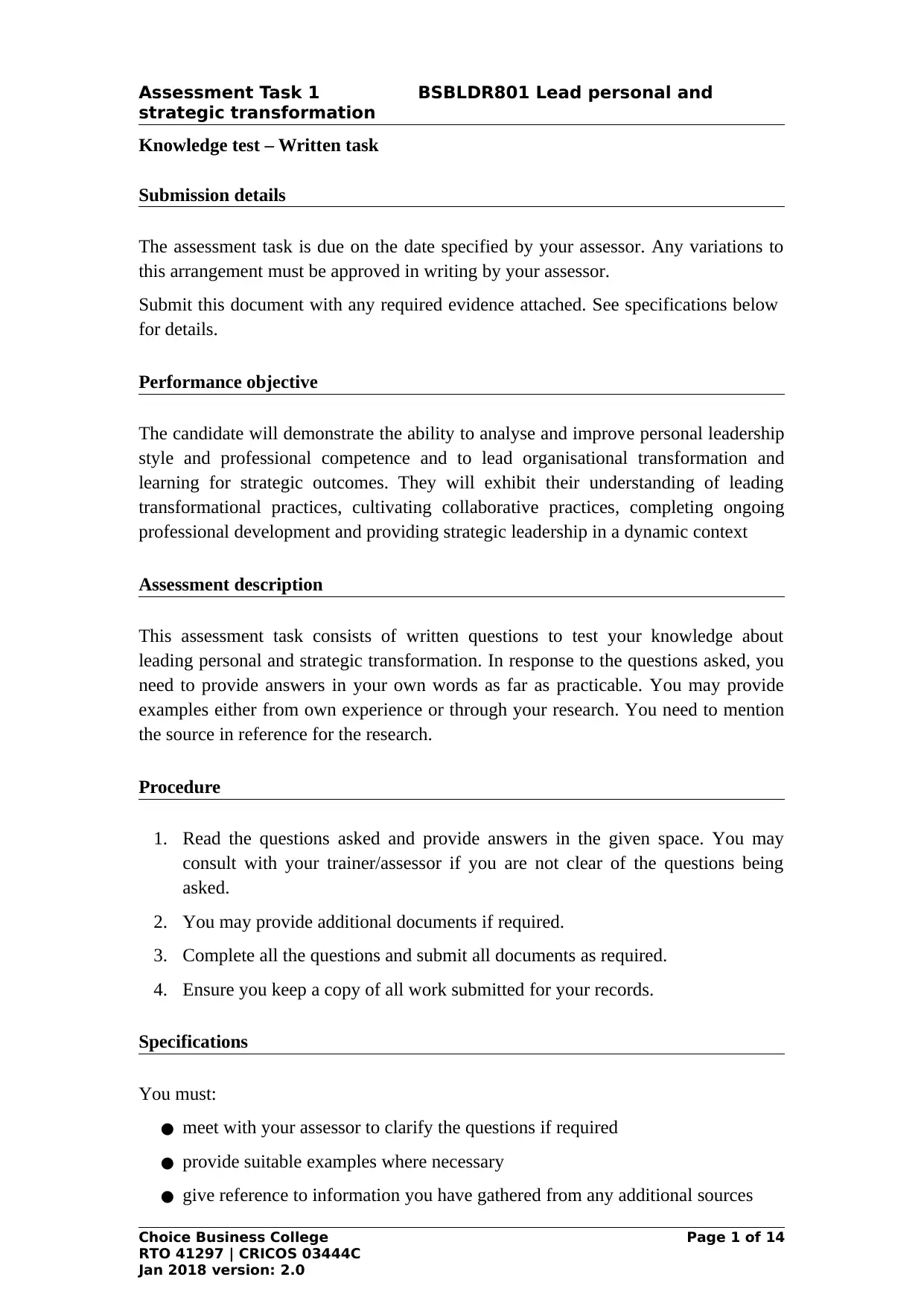
Assessment Task 1 BSBLDR801 Lead personal and
strategic transformation
Knowledge test – Written task
Submission details
The assessment task is due on the date specified by your assessor. Any variations to
this arrangement must be approved in writing by your assessor.
Submit this document with any required evidence attached. See specifications below
for details.
Performance objective
The candidate will demonstrate the ability to analyse and improve personal leadership
style and professional competence and to lead organisational transformation and
learning for strategic outcomes. They will exhibit their understanding of leading
transformational practices, cultivating collaborative practices, completing ongoing
professional development and providing strategic leadership in a dynamic context
Assessment description
This assessment task consists of written questions to test your knowledge about
leading personal and strategic transformation. In response to the questions asked, you
need to provide answers in your own words as far as practicable. You may provide
examples either from own experience or through your research. You need to mention
the source in reference for the research.
Procedure
1. Read the questions asked and provide answers in the given space. You may
consult with your trainer/assessor if you are not clear of the questions being
asked.
2. You may provide additional documents if required.
3. Complete all the questions and submit all documents as required.
4. Ensure you keep a copy of all work submitted for your records.
Specifications
You must:
● meet with your assessor to clarify the questions if required
● provide suitable examples where necessary
● give reference to information you have gathered from any additional sources
Choice Business College Page 1 of 14
RTO 41297 | CRICOS 03444C
Jan 2018 version: 2.0
strategic transformation
Knowledge test – Written task
Submission details
The assessment task is due on the date specified by your assessor. Any variations to
this arrangement must be approved in writing by your assessor.
Submit this document with any required evidence attached. See specifications below
for details.
Performance objective
The candidate will demonstrate the ability to analyse and improve personal leadership
style and professional competence and to lead organisational transformation and
learning for strategic outcomes. They will exhibit their understanding of leading
transformational practices, cultivating collaborative practices, completing ongoing
professional development and providing strategic leadership in a dynamic context
Assessment description
This assessment task consists of written questions to test your knowledge about
leading personal and strategic transformation. In response to the questions asked, you
need to provide answers in your own words as far as practicable. You may provide
examples either from own experience or through your research. You need to mention
the source in reference for the research.
Procedure
1. Read the questions asked and provide answers in the given space. You may
consult with your trainer/assessor if you are not clear of the questions being
asked.
2. You may provide additional documents if required.
3. Complete all the questions and submit all documents as required.
4. Ensure you keep a copy of all work submitted for your records.
Specifications
You must:
● meet with your assessor to clarify the questions if required
● provide suitable examples where necessary
● give reference to information you have gathered from any additional sources
Choice Business College Page 1 of 14
RTO 41297 | CRICOS 03444C
Jan 2018 version: 2.0
Paraphrase This Document
Need a fresh take? Get an instant paraphrase of this document with our AI Paraphraser

Assessment Task 1 BSBLDR801 Lead personal and
strategic transformation
● submit your notes.
Your assessor will be looking for:
● reflect on and improve own development, personal leadership style and self-
management skills
● demonstrate the application of leadership styles and approaches appropriate to
individuals involved, the outcomes being sought and the context
● model and encourage collaboration
● provide strategic leadership during a change process
● effectively manage workplace relationships
● analyse relevant legislation, information and intelligence sources.
Adjustment for distance-based learners
● No variation of the task is required.
● Documentation can be submitted electronically or posted in the mail.
Choice Business College Page 2 of 14
RTO 41297 | CRICOS 03444C
Jan 2018 version: 2.0
strategic transformation
● submit your notes.
Your assessor will be looking for:
● reflect on and improve own development, personal leadership style and self-
management skills
● demonstrate the application of leadership styles and approaches appropriate to
individuals involved, the outcomes being sought and the context
● model and encourage collaboration
● provide strategic leadership during a change process
● effectively manage workplace relationships
● analyse relevant legislation, information and intelligence sources.
Adjustment for distance-based learners
● No variation of the task is required.
● Documentation can be submitted electronically or posted in the mail.
Choice Business College Page 2 of 14
RTO 41297 | CRICOS 03444C
Jan 2018 version: 2.0
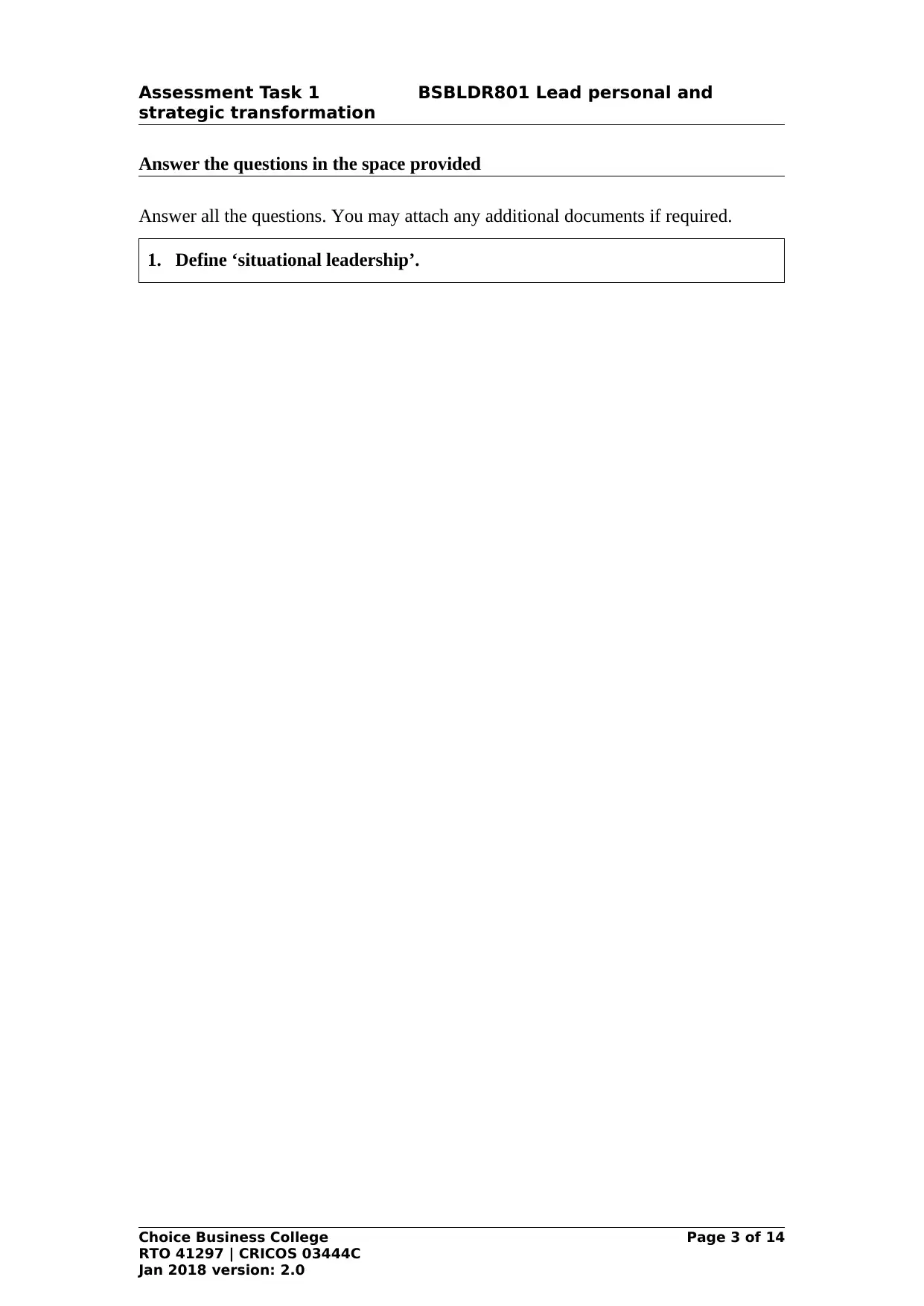
Assessment Task 1 BSBLDR801 Lead personal and
strategic transformation
Answer the questions in the space provided
Answer all the questions. You may attach any additional documents if required.
1. Define ‘situational leadership’.
Choice Business College Page 3 of 14
RTO 41297 | CRICOS 03444C
Jan 2018 version: 2.0
strategic transformation
Answer the questions in the space provided
Answer all the questions. You may attach any additional documents if required.
1. Define ‘situational leadership’.
Choice Business College Page 3 of 14
RTO 41297 | CRICOS 03444C
Jan 2018 version: 2.0
⊘ This is a preview!⊘
Do you want full access?
Subscribe today to unlock all pages.

Trusted by 1+ million students worldwide

Assessment Task 1 BSBLDR801 Lead personal and
strategic transformation
Leadership plays a major role in managing the human resources of the organization
and also facilitate the business functioning. Du to this, it is important for the leader
of the organization to adjust his leadership style according to the situation to ensure
growth and development of the subordinates and followers, i.e., the employees of
the organization. The main aim of the situational leadership is to influence the
employees by adjusting to the present condition and adopt a leadership style that
can be suitable for improving the level of growth and development of the
employees within the workplace (McCleskey 2014). This kind of leadership style
allows the leader or manager of the organization to change the leadership and
working style whenever required, furthermore, ensure meeting the needs of people
within the workplace according to the current situation. The situational leadership
style is a top down approach to leadership and has often been facilitated with the
leader making effective decisions to manage change though allowing the team
members to follow what the leader want to do. The leader has been associated with
the coaching of employees and delegating the right tasks to the employees based on
their skills and areas of interests, which could make them perform to their potential
for accomplishing the tasks quickly and effectively (Giltinane 2013).
2. How is transactional leadership different to transformational leadership?
Choice Business College Page 4 of 14
RTO 41297 | CRICOS 03444C
Jan 2018 version: 2.0
strategic transformation
Leadership plays a major role in managing the human resources of the organization
and also facilitate the business functioning. Du to this, it is important for the leader
of the organization to adjust his leadership style according to the situation to ensure
growth and development of the subordinates and followers, i.e., the employees of
the organization. The main aim of the situational leadership is to influence the
employees by adjusting to the present condition and adopt a leadership style that
can be suitable for improving the level of growth and development of the
employees within the workplace (McCleskey 2014). This kind of leadership style
allows the leader or manager of the organization to change the leadership and
working style whenever required, furthermore, ensure meeting the needs of people
within the workplace according to the current situation. The situational leadership
style is a top down approach to leadership and has often been facilitated with the
leader making effective decisions to manage change though allowing the team
members to follow what the leader want to do. The leader has been associated with
the coaching of employees and delegating the right tasks to the employees based on
their skills and areas of interests, which could make them perform to their potential
for accomplishing the tasks quickly and effectively (Giltinane 2013).
2. How is transactional leadership different to transformational leadership?
Choice Business College Page 4 of 14
RTO 41297 | CRICOS 03444C
Jan 2018 version: 2.0
Paraphrase This Document
Need a fresh take? Get an instant paraphrase of this document with our AI Paraphraser
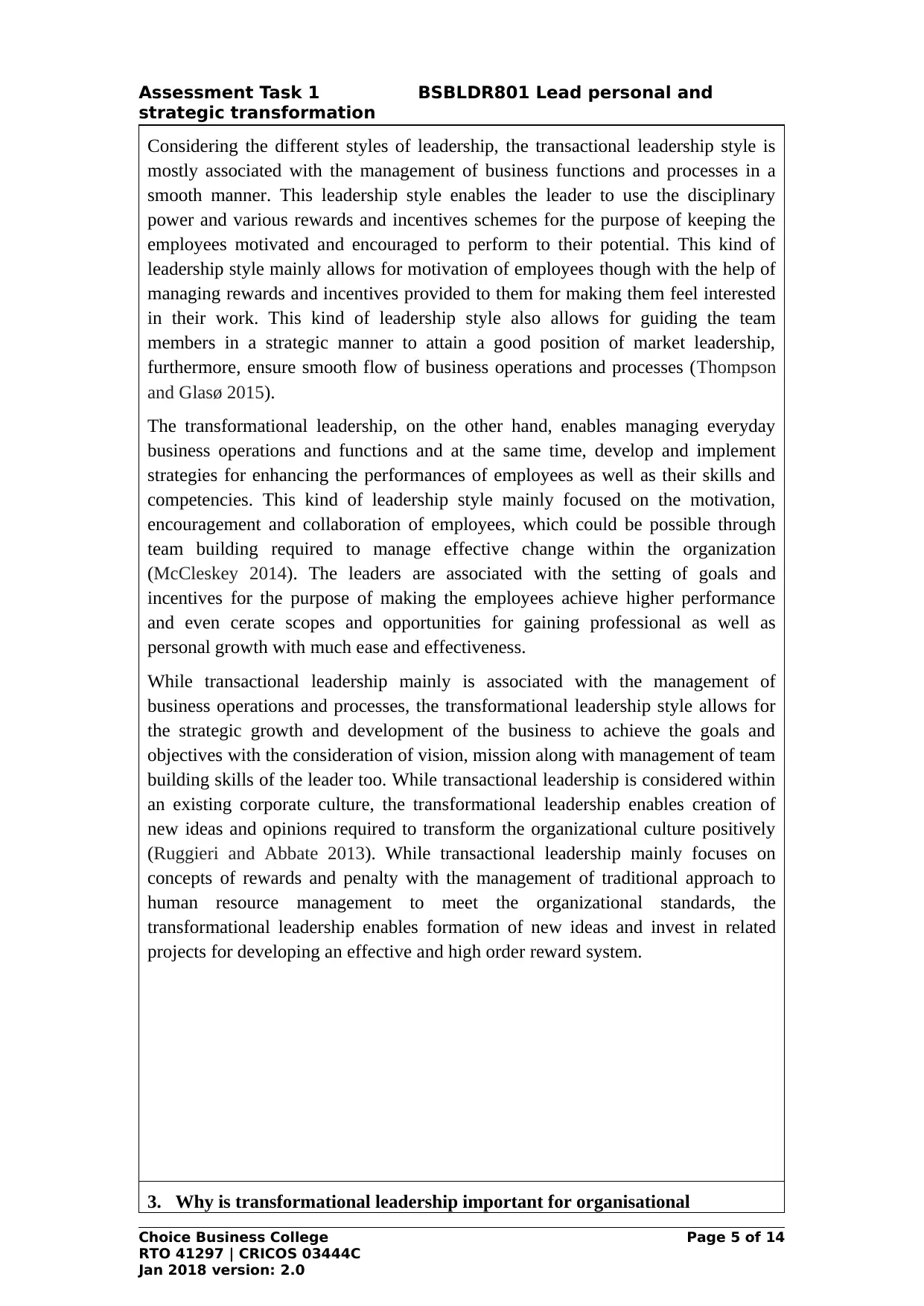
Assessment Task 1 BSBLDR801 Lead personal and
strategic transformation
Considering the different styles of leadership, the transactional leadership style is
mostly associated with the management of business functions and processes in a
smooth manner. This leadership style enables the leader to use the disciplinary
power and various rewards and incentives schemes for the purpose of keeping the
employees motivated and encouraged to perform to their potential. This kind of
leadership style mainly allows for motivation of employees though with the help of
managing rewards and incentives provided to them for making them feel interested
in their work. This kind of leadership style also allows for guiding the team
members in a strategic manner to attain a good position of market leadership,
furthermore, ensure smooth flow of business operations and processes (Thompson
and Glasø 2015).
The transformational leadership, on the other hand, enables managing everyday
business operations and functions and at the same time, develop and implement
strategies for enhancing the performances of employees as well as their skills and
competencies. This kind of leadership style mainly focused on the motivation,
encouragement and collaboration of employees, which could be possible through
team building required to manage effective change within the organization
(McCleskey 2014). The leaders are associated with the setting of goals and
incentives for the purpose of making the employees achieve higher performance
and even cerate scopes and opportunities for gaining professional as well as
personal growth with much ease and effectiveness.
While transactional leadership mainly is associated with the management of
business operations and processes, the transformational leadership style allows for
the strategic growth and development of the business to achieve the goals and
objectives with the consideration of vision, mission along with management of team
building skills of the leader too. While transactional leadership is considered within
an existing corporate culture, the transformational leadership enables creation of
new ideas and opinions required to transform the organizational culture positively
(Ruggieri and Abbate 2013). While transactional leadership mainly focuses on
concepts of rewards and penalty with the management of traditional approach to
human resource management to meet the organizational standards, the
transformational leadership enables formation of new ideas and invest in related
projects for developing an effective and high order reward system.
3. Why is transformational leadership important for organisational
Choice Business College Page 5 of 14
RTO 41297 | CRICOS 03444C
Jan 2018 version: 2.0
strategic transformation
Considering the different styles of leadership, the transactional leadership style is
mostly associated with the management of business functions and processes in a
smooth manner. This leadership style enables the leader to use the disciplinary
power and various rewards and incentives schemes for the purpose of keeping the
employees motivated and encouraged to perform to their potential. This kind of
leadership style mainly allows for motivation of employees though with the help of
managing rewards and incentives provided to them for making them feel interested
in their work. This kind of leadership style also allows for guiding the team
members in a strategic manner to attain a good position of market leadership,
furthermore, ensure smooth flow of business operations and processes (Thompson
and Glasø 2015).
The transformational leadership, on the other hand, enables managing everyday
business operations and functions and at the same time, develop and implement
strategies for enhancing the performances of employees as well as their skills and
competencies. This kind of leadership style mainly focused on the motivation,
encouragement and collaboration of employees, which could be possible through
team building required to manage effective change within the organization
(McCleskey 2014). The leaders are associated with the setting of goals and
incentives for the purpose of making the employees achieve higher performance
and even cerate scopes and opportunities for gaining professional as well as
personal growth with much ease and effectiveness.
While transactional leadership mainly is associated with the management of
business operations and processes, the transformational leadership style allows for
the strategic growth and development of the business to achieve the goals and
objectives with the consideration of vision, mission along with management of team
building skills of the leader too. While transactional leadership is considered within
an existing corporate culture, the transformational leadership enables creation of
new ideas and opinions required to transform the organizational culture positively
(Ruggieri and Abbate 2013). While transactional leadership mainly focuses on
concepts of rewards and penalty with the management of traditional approach to
human resource management to meet the organizational standards, the
transformational leadership enables formation of new ideas and invest in related
projects for developing an effective and high order reward system.
3. Why is transformational leadership important for organisational
Choice Business College Page 5 of 14
RTO 41297 | CRICOS 03444C
Jan 2018 version: 2.0
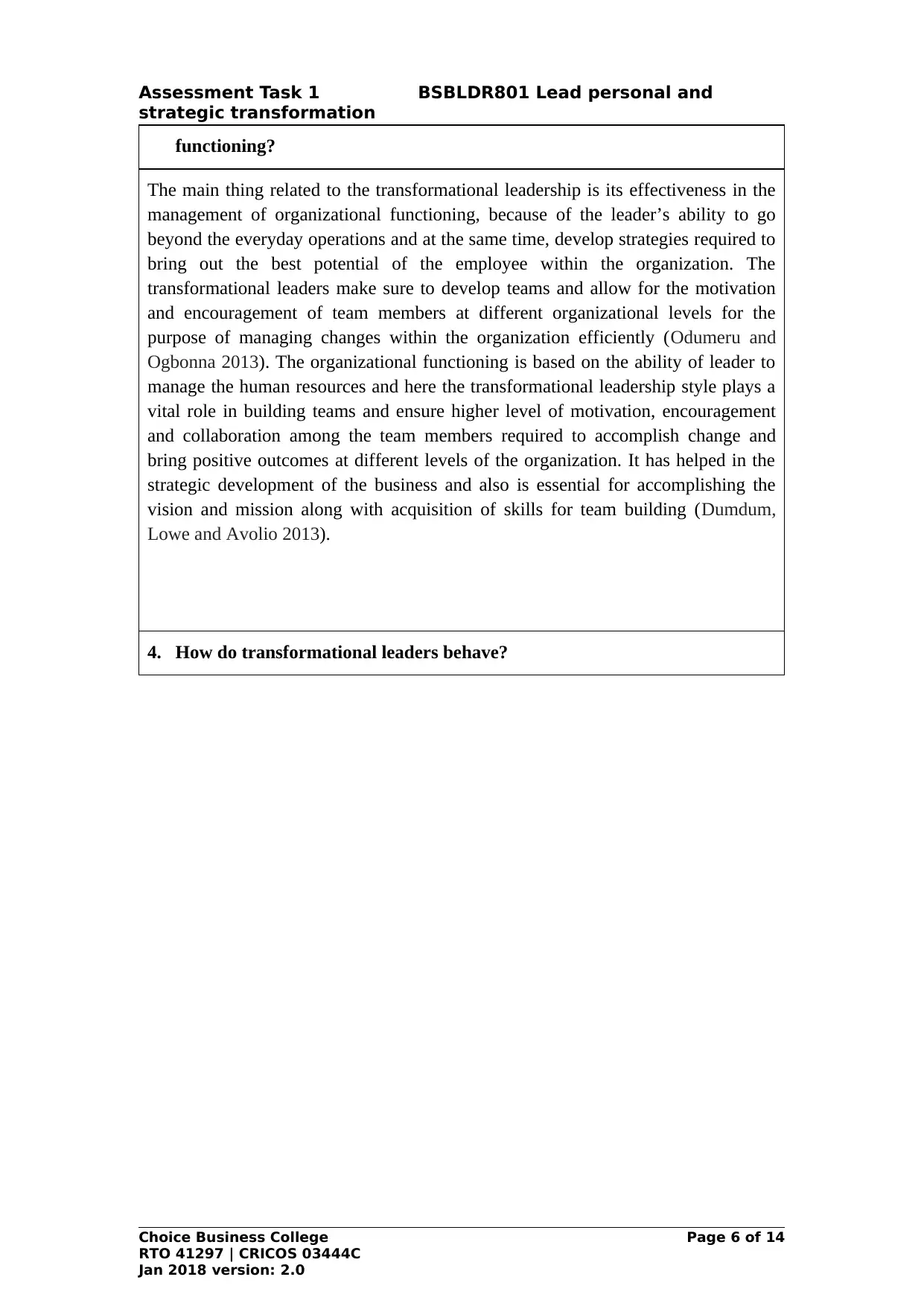
Assessment Task 1 BSBLDR801 Lead personal and
strategic transformation
functioning?
The main thing related to the transformational leadership is its effectiveness in the
management of organizational functioning, because of the leader’s ability to go
beyond the everyday operations and at the same time, develop strategies required to
bring out the best potential of the employee within the organization. The
transformational leaders make sure to develop teams and allow for the motivation
and encouragement of team members at different organizational levels for the
purpose of managing changes within the organization efficiently (Odumeru and
Ogbonna 2013). The organizational functioning is based on the ability of leader to
manage the human resources and here the transformational leadership style plays a
vital role in building teams and ensure higher level of motivation, encouragement
and collaboration among the team members required to accomplish change and
bring positive outcomes at different levels of the organization. It has helped in the
strategic development of the business and also is essential for accomplishing the
vision and mission along with acquisition of skills for team building (Dumdum,
Lowe and Avolio 2013).
4. How do transformational leaders behave?
Choice Business College Page 6 of 14
RTO 41297 | CRICOS 03444C
Jan 2018 version: 2.0
strategic transformation
functioning?
The main thing related to the transformational leadership is its effectiveness in the
management of organizational functioning, because of the leader’s ability to go
beyond the everyday operations and at the same time, develop strategies required to
bring out the best potential of the employee within the organization. The
transformational leaders make sure to develop teams and allow for the motivation
and encouragement of team members at different organizational levels for the
purpose of managing changes within the organization efficiently (Odumeru and
Ogbonna 2013). The organizational functioning is based on the ability of leader to
manage the human resources and here the transformational leadership style plays a
vital role in building teams and ensure higher level of motivation, encouragement
and collaboration among the team members required to accomplish change and
bring positive outcomes at different levels of the organization. It has helped in the
strategic development of the business and also is essential for accomplishing the
vision and mission along with acquisition of skills for team building (Dumdum,
Lowe and Avolio 2013).
4. How do transformational leaders behave?
Choice Business College Page 6 of 14
RTO 41297 | CRICOS 03444C
Jan 2018 version: 2.0
⊘ This is a preview!⊘
Do you want full access?
Subscribe today to unlock all pages.

Trusted by 1+ million students worldwide
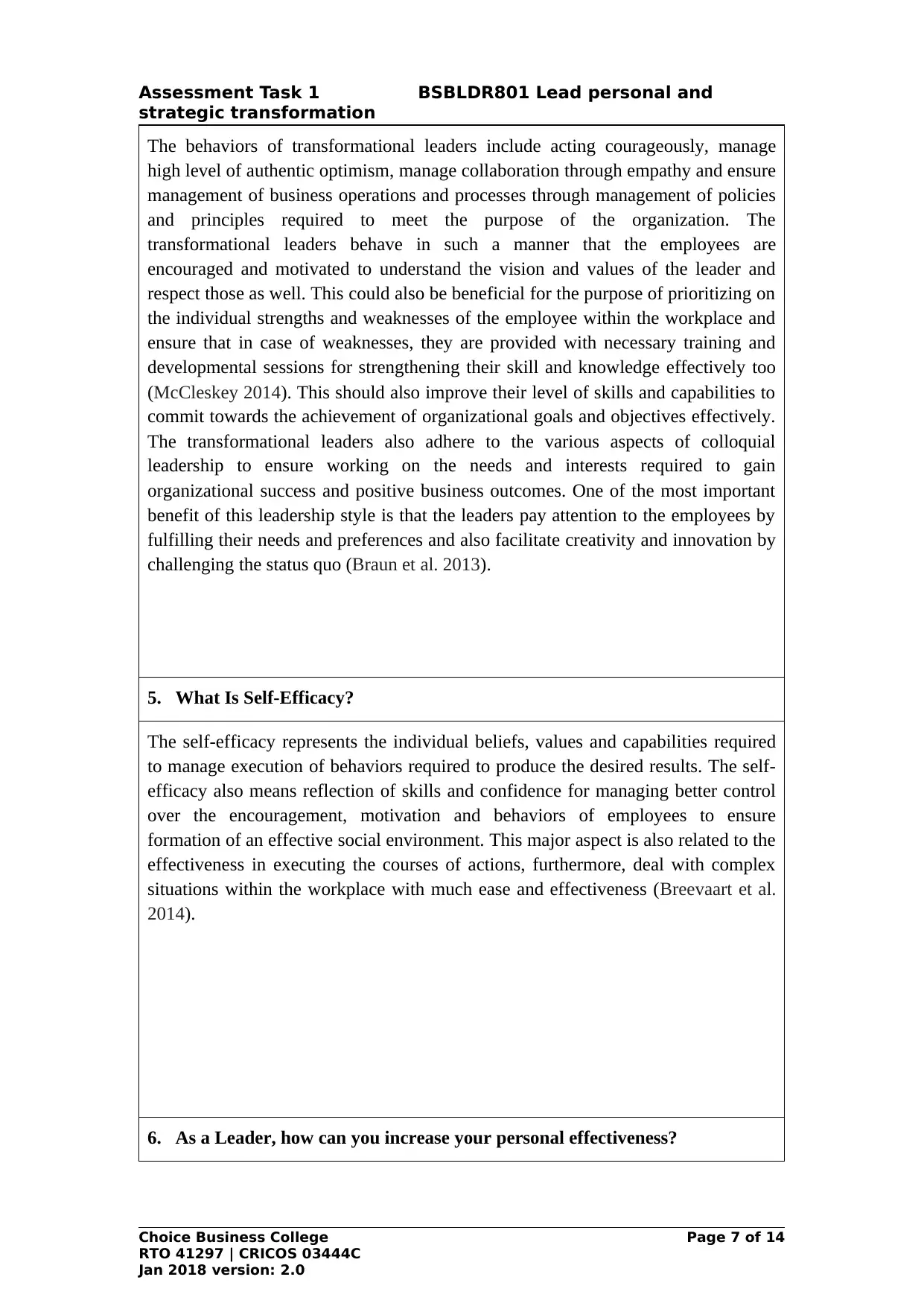
Assessment Task 1 BSBLDR801 Lead personal and
strategic transformation
The behaviors of transformational leaders include acting courageously, manage
high level of authentic optimism, manage collaboration through empathy and ensure
management of business operations and processes through management of policies
and principles required to meet the purpose of the organization. The
transformational leaders behave in such a manner that the employees are
encouraged and motivated to understand the vision and values of the leader and
respect those as well. This could also be beneficial for the purpose of prioritizing on
the individual strengths and weaknesses of the employee within the workplace and
ensure that in case of weaknesses, they are provided with necessary training and
developmental sessions for strengthening their skill and knowledge effectively too
(McCleskey 2014). This should also improve their level of skills and capabilities to
commit towards the achievement of organizational goals and objectives effectively.
The transformational leaders also adhere to the various aspects of colloquial
leadership to ensure working on the needs and interests required to gain
organizational success and positive business outcomes. One of the most important
benefit of this leadership style is that the leaders pay attention to the employees by
fulfilling their needs and preferences and also facilitate creativity and innovation by
challenging the status quo (Braun et al. 2013).
5. What Is Self-Efficacy?
The self-efficacy represents the individual beliefs, values and capabilities required
to manage execution of behaviors required to produce the desired results. The self-
efficacy also means reflection of skills and confidence for managing better control
over the encouragement, motivation and behaviors of employees to ensure
formation of an effective social environment. This major aspect is also related to the
effectiveness in executing the courses of actions, furthermore, deal with complex
situations within the workplace with much ease and effectiveness (Breevaart et al.
2014).
6. As a Leader, how can you increase your personal effectiveness?
Choice Business College Page 7 of 14
RTO 41297 | CRICOS 03444C
Jan 2018 version: 2.0
strategic transformation
The behaviors of transformational leaders include acting courageously, manage
high level of authentic optimism, manage collaboration through empathy and ensure
management of business operations and processes through management of policies
and principles required to meet the purpose of the organization. The
transformational leaders behave in such a manner that the employees are
encouraged and motivated to understand the vision and values of the leader and
respect those as well. This could also be beneficial for the purpose of prioritizing on
the individual strengths and weaknesses of the employee within the workplace and
ensure that in case of weaknesses, they are provided with necessary training and
developmental sessions for strengthening their skill and knowledge effectively too
(McCleskey 2014). This should also improve their level of skills and capabilities to
commit towards the achievement of organizational goals and objectives effectively.
The transformational leaders also adhere to the various aspects of colloquial
leadership to ensure working on the needs and interests required to gain
organizational success and positive business outcomes. One of the most important
benefit of this leadership style is that the leaders pay attention to the employees by
fulfilling their needs and preferences and also facilitate creativity and innovation by
challenging the status quo (Braun et al. 2013).
5. What Is Self-Efficacy?
The self-efficacy represents the individual beliefs, values and capabilities required
to manage execution of behaviors required to produce the desired results. The self-
efficacy also means reflection of skills and confidence for managing better control
over the encouragement, motivation and behaviors of employees to ensure
formation of an effective social environment. This major aspect is also related to the
effectiveness in executing the courses of actions, furthermore, deal with complex
situations within the workplace with much ease and effectiveness (Breevaart et al.
2014).
6. As a Leader, how can you increase your personal effectiveness?
Choice Business College Page 7 of 14
RTO 41297 | CRICOS 03444C
Jan 2018 version: 2.0
Paraphrase This Document
Need a fresh take? Get an instant paraphrase of this document with our AI Paraphraser

Assessment Task 1 BSBLDR801 Lead personal and
strategic transformation
As a leader, to increase the personal effectiveness, I would like to remain passionate
and confident about approaching things and ensure doing the things the right way.
The never give up attitude should also hold special importance in the form of
managing innovation, furthermore, show great enthusiasm to achieve the end
results. With the passion, there would be enough scopes for the development of
leadership skills through pursuit in learning and also ensure inspiring the employees
to work together in a collaborative way. The understanding of strengths and
weaknesses should also assist in learning individual abilities and at the same time,
allow me to focus on the areas of weaknesses through addressing of shortcomings
required to gain professional growth, I would like to prioritize on team work, which
can reduce workload and time and t should be possible from investing time to
clarify the goals and objectives, furthermore follow a proper methodology to guide
the business in the upcoming days to come (Odumeru and Ogbonna 2013). It is my
responsibility to motivate the employees and empower them to work harder and it
should be done by monitoring their performances, furthermore, identify their
developmental needs and train them to strengthen their ability and even raise their
morale level. This would impart greater knowledge and create positive vibes or
energy among them to do the right things at the right time and ensure everything
goes according to the plan.
7. There are several qualities associated with servant leadership. With regard
to leadership and role models, outline any three (3) of the following
qualities:
Awareness
Commitment
Empathy
Foresight
Listening
Persuasion
Choice Business College Page 8 of 14
RTO 41297 | CRICOS 03444C
Jan 2018 version: 2.0
strategic transformation
As a leader, to increase the personal effectiveness, I would like to remain passionate
and confident about approaching things and ensure doing the things the right way.
The never give up attitude should also hold special importance in the form of
managing innovation, furthermore, show great enthusiasm to achieve the end
results. With the passion, there would be enough scopes for the development of
leadership skills through pursuit in learning and also ensure inspiring the employees
to work together in a collaborative way. The understanding of strengths and
weaknesses should also assist in learning individual abilities and at the same time,
allow me to focus on the areas of weaknesses through addressing of shortcomings
required to gain professional growth, I would like to prioritize on team work, which
can reduce workload and time and t should be possible from investing time to
clarify the goals and objectives, furthermore follow a proper methodology to guide
the business in the upcoming days to come (Odumeru and Ogbonna 2013). It is my
responsibility to motivate the employees and empower them to work harder and it
should be done by monitoring their performances, furthermore, identify their
developmental needs and train them to strengthen their ability and even raise their
morale level. This would impart greater knowledge and create positive vibes or
energy among them to do the right things at the right time and ensure everything
goes according to the plan.
7. There are several qualities associated with servant leadership. With regard
to leadership and role models, outline any three (3) of the following
qualities:
Awareness
Commitment
Empathy
Foresight
Listening
Persuasion
Choice Business College Page 8 of 14
RTO 41297 | CRICOS 03444C
Jan 2018 version: 2.0
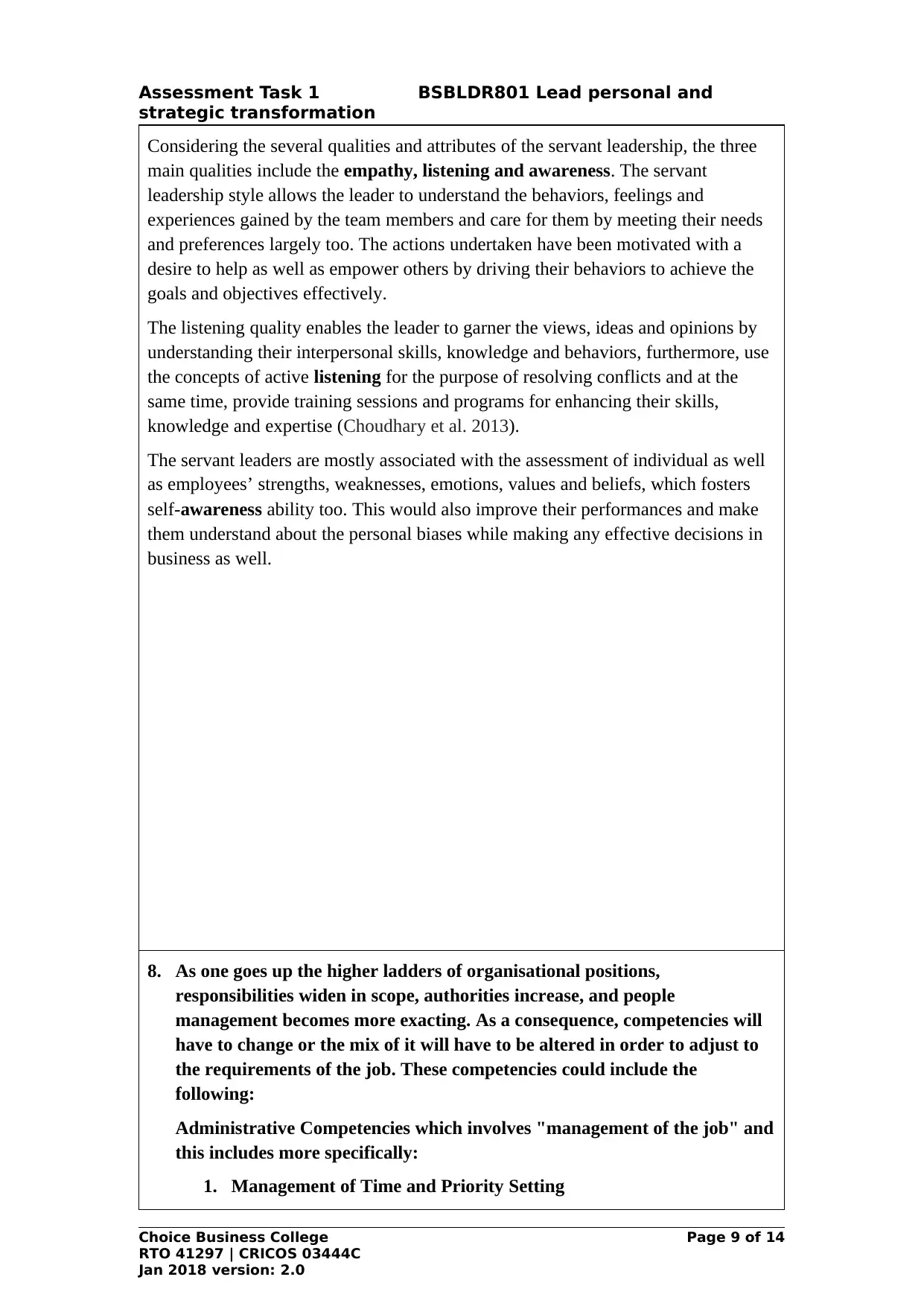
Assessment Task 1 BSBLDR801 Lead personal and
strategic transformation
Considering the several qualities and attributes of the servant leadership, the three
main qualities include the empathy, listening and awareness. The servant
leadership style allows the leader to understand the behaviors, feelings and
experiences gained by the team members and care for them by meeting their needs
and preferences largely too. The actions undertaken have been motivated with a
desire to help as well as empower others by driving their behaviors to achieve the
goals and objectives effectively.
The listening quality enables the leader to garner the views, ideas and opinions by
understanding their interpersonal skills, knowledge and behaviors, furthermore, use
the concepts of active listening for the purpose of resolving conflicts and at the
same time, provide training sessions and programs for enhancing their skills,
knowledge and expertise (Choudhary et al. 2013).
The servant leaders are mostly associated with the assessment of individual as well
as employees’ strengths, weaknesses, emotions, values and beliefs, which fosters
self-awareness ability too. This would also improve their performances and make
them understand about the personal biases while making any effective decisions in
business as well.
8. As one goes up the higher ladders of organisational positions,
responsibilities widen in scope, authorities increase, and people
management becomes more exacting. As a consequence, competencies will
have to change or the mix of it will have to be altered in order to adjust to
the requirements of the job. These competencies could include the
following:
Administrative Competencies which involves "management of the job" and
this includes more specifically:
1. Management of Time and Priority Setting
Choice Business College Page 9 of 14
RTO 41297 | CRICOS 03444C
Jan 2018 version: 2.0
strategic transformation
Considering the several qualities and attributes of the servant leadership, the three
main qualities include the empathy, listening and awareness. The servant
leadership style allows the leader to understand the behaviors, feelings and
experiences gained by the team members and care for them by meeting their needs
and preferences largely too. The actions undertaken have been motivated with a
desire to help as well as empower others by driving their behaviors to achieve the
goals and objectives effectively.
The listening quality enables the leader to garner the views, ideas and opinions by
understanding their interpersonal skills, knowledge and behaviors, furthermore, use
the concepts of active listening for the purpose of resolving conflicts and at the
same time, provide training sessions and programs for enhancing their skills,
knowledge and expertise (Choudhary et al. 2013).
The servant leaders are mostly associated with the assessment of individual as well
as employees’ strengths, weaknesses, emotions, values and beliefs, which fosters
self-awareness ability too. This would also improve their performances and make
them understand about the personal biases while making any effective decisions in
business as well.
8. As one goes up the higher ladders of organisational positions,
responsibilities widen in scope, authorities increase, and people
management becomes more exacting. As a consequence, competencies will
have to change or the mix of it will have to be altered in order to adjust to
the requirements of the job. These competencies could include the
following:
Administrative Competencies which involves "management of the job" and
this includes more specifically:
1. Management of Time and Priority Setting
Choice Business College Page 9 of 14
RTO 41297 | CRICOS 03444C
Jan 2018 version: 2.0
⊘ This is a preview!⊘
Do you want full access?
Subscribe today to unlock all pages.

Trusted by 1+ million students worldwide
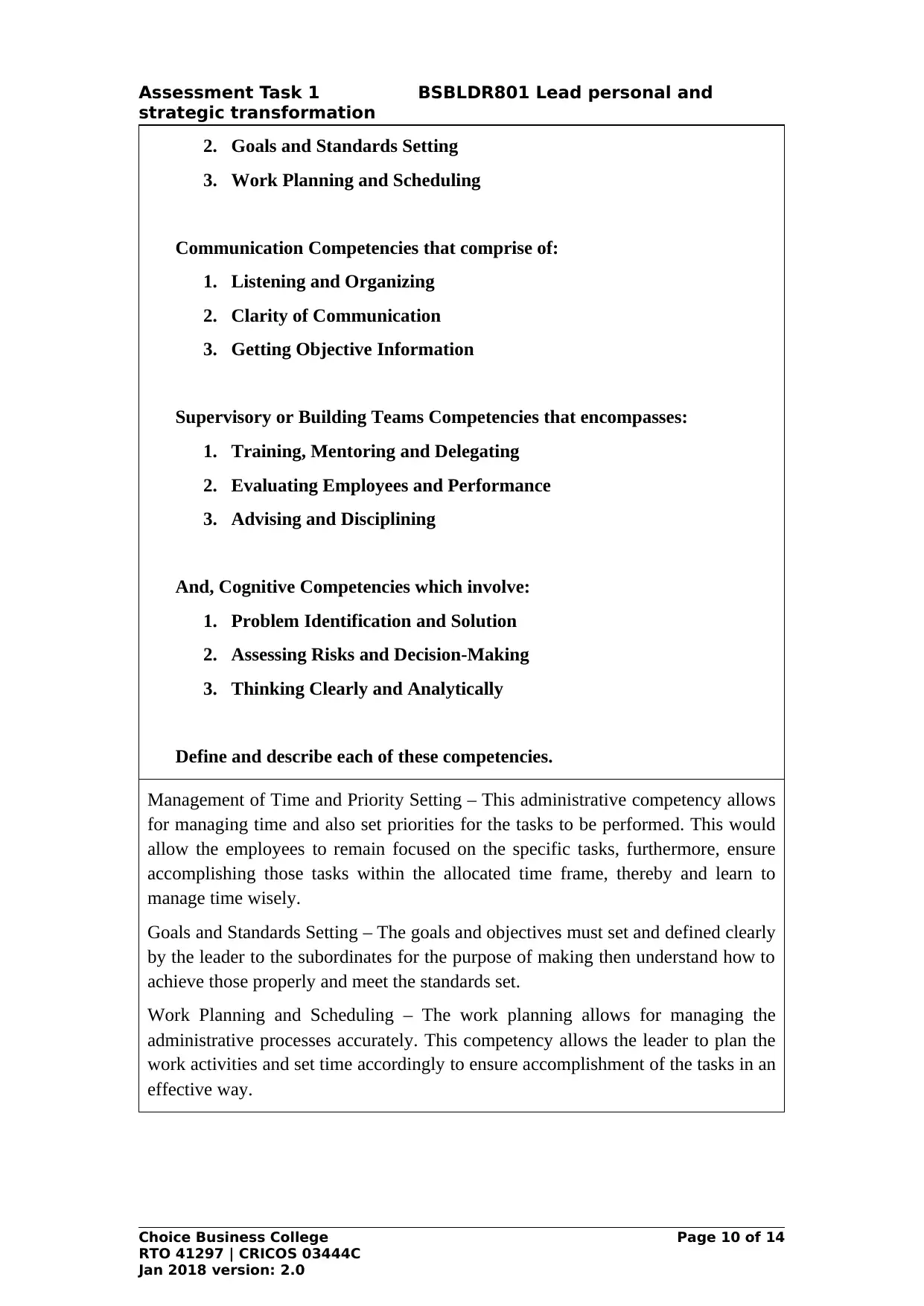
Assessment Task 1 BSBLDR801 Lead personal and
strategic transformation
2. Goals and Standards Setting
3. Work Planning and Scheduling
Communication Competencies that comprise of:
1. Listening and Organizing
2. Clarity of Communication
3. Getting Objective Information
Supervisory or Building Teams Competencies that encompasses:
1. Training, Mentoring and Delegating
2. Evaluating Employees and Performance
3. Advising and Disciplining
And, Cognitive Competencies which involve:
1. Problem Identification and Solution
2. Assessing Risks and Decision-Making
3. Thinking Clearly and Analytically
Define and describe each of these competencies.
Management of Time and Priority Setting – This administrative competency allows
for managing time and also set priorities for the tasks to be performed. This would
allow the employees to remain focused on the specific tasks, furthermore, ensure
accomplishing those tasks within the allocated time frame, thereby and learn to
manage time wisely.
Goals and Standards Setting – The goals and objectives must set and defined clearly
by the leader to the subordinates for the purpose of making then understand how to
achieve those properly and meet the standards set.
Work Planning and Scheduling – The work planning allows for managing the
administrative processes accurately. This competency allows the leader to plan the
work activities and set time accordingly to ensure accomplishment of the tasks in an
effective way.
Choice Business College Page 10 of 14
RTO 41297 | CRICOS 03444C
Jan 2018 version: 2.0
strategic transformation
2. Goals and Standards Setting
3. Work Planning and Scheduling
Communication Competencies that comprise of:
1. Listening and Organizing
2. Clarity of Communication
3. Getting Objective Information
Supervisory or Building Teams Competencies that encompasses:
1. Training, Mentoring and Delegating
2. Evaluating Employees and Performance
3. Advising and Disciplining
And, Cognitive Competencies which involve:
1. Problem Identification and Solution
2. Assessing Risks and Decision-Making
3. Thinking Clearly and Analytically
Define and describe each of these competencies.
Management of Time and Priority Setting – This administrative competency allows
for managing time and also set priorities for the tasks to be performed. This would
allow the employees to remain focused on the specific tasks, furthermore, ensure
accomplishing those tasks within the allocated time frame, thereby and learn to
manage time wisely.
Goals and Standards Setting – The goals and objectives must set and defined clearly
by the leader to the subordinates for the purpose of making then understand how to
achieve those properly and meet the standards set.
Work Planning and Scheduling – The work planning allows for managing the
administrative processes accurately. This competency allows the leader to plan the
work activities and set time accordingly to ensure accomplishment of the tasks in an
effective way.
Choice Business College Page 10 of 14
RTO 41297 | CRICOS 03444C
Jan 2018 version: 2.0
Paraphrase This Document
Need a fresh take? Get an instant paraphrase of this document with our AI Paraphraser

Assessment Task 1 BSBLDR801 Lead personal and
strategic transformation
The communication skills and competency are managed by the leader to foster
greater communication and ensure collaborative working within the workplace.
Listening and Organizing- The leader must communicate the vision, mission,
values and objectives to the employees, who must participate in the discussion and
actively listen to what the leader want to say (Robbins, DeCenzo and Wolter 2013).
Clarity of Communication- The clarity of communication would be maintained
when the sender transfers the right messages and information to the receiver. The
leader must share the organizational values, beliefs and about the vision and
mission to ensure proper communication between the leader and employees, which
should also help in clarifying the goals and objectives set.
Getting Objective Information- The leader could share objective information with
the employees and make sure that they understand those properly to clarify their
roles, responsibilities and tasks that have been delegated.
Supervisory or Building Teams Competencies:
Training, Mentoring and Delegating- The leader must monitor performances of
employees and identify their needs for development to determine the areas of
weaknesses. Based on this, necessary training and mentoring sessions should be
arranged for enhancing their skills and competency level (Hardison et al. 2014).
Evaluating Employees and Performance- The monitoring of performances should
assist in evaluating their performances and also their areas of weaknesses where
they lacked certain skills and knowledge.
Advising and Disciplining- Though the leader should keep the workplace
disciplined and advise the team memebrs to respect the values and beliefs, he also
must be aware of capturing their ideas, views and opinions, furthermore, ensure
maintaining a good working environment and culture.
Cognitive Competencies:
Problem Identification and Solution- The cognitive competency of an individual
with higher position within the organization allows for identification of problems
experienced and deliver a good solution through discussions managed between the
team members.
Assessing Risks and Decision-Making- The assessment of risks and rating those
according to the severity allows for handling those risks effectively and deliver a
good solution to ensure that the risks does not emerge again (Waite and McKinney
2014).
Thinking Clearly and Analytically- The analytical thinking has to be supported by
clear thinking and by making the employees empowered through knowledge and
information acquisition regarding the goals and objectives that are set clearly.
Choice Business College Page 11 of 14
RTO 41297 | CRICOS 03444C
Jan 2018 version: 2.0
strategic transformation
The communication skills and competency are managed by the leader to foster
greater communication and ensure collaborative working within the workplace.
Listening and Organizing- The leader must communicate the vision, mission,
values and objectives to the employees, who must participate in the discussion and
actively listen to what the leader want to say (Robbins, DeCenzo and Wolter 2013).
Clarity of Communication- The clarity of communication would be maintained
when the sender transfers the right messages and information to the receiver. The
leader must share the organizational values, beliefs and about the vision and
mission to ensure proper communication between the leader and employees, which
should also help in clarifying the goals and objectives set.
Getting Objective Information- The leader could share objective information with
the employees and make sure that they understand those properly to clarify their
roles, responsibilities and tasks that have been delegated.
Supervisory or Building Teams Competencies:
Training, Mentoring and Delegating- The leader must monitor performances of
employees and identify their needs for development to determine the areas of
weaknesses. Based on this, necessary training and mentoring sessions should be
arranged for enhancing their skills and competency level (Hardison et al. 2014).
Evaluating Employees and Performance- The monitoring of performances should
assist in evaluating their performances and also their areas of weaknesses where
they lacked certain skills and knowledge.
Advising and Disciplining- Though the leader should keep the workplace
disciplined and advise the team memebrs to respect the values and beliefs, he also
must be aware of capturing their ideas, views and opinions, furthermore, ensure
maintaining a good working environment and culture.
Cognitive Competencies:
Problem Identification and Solution- The cognitive competency of an individual
with higher position within the organization allows for identification of problems
experienced and deliver a good solution through discussions managed between the
team members.
Assessing Risks and Decision-Making- The assessment of risks and rating those
according to the severity allows for handling those risks effectively and deliver a
good solution to ensure that the risks does not emerge again (Waite and McKinney
2014).
Thinking Clearly and Analytically- The analytical thinking has to be supported by
clear thinking and by making the employees empowered through knowledge and
information acquisition regarding the goals and objectives that are set clearly.
Choice Business College Page 11 of 14
RTO 41297 | CRICOS 03444C
Jan 2018 version: 2.0
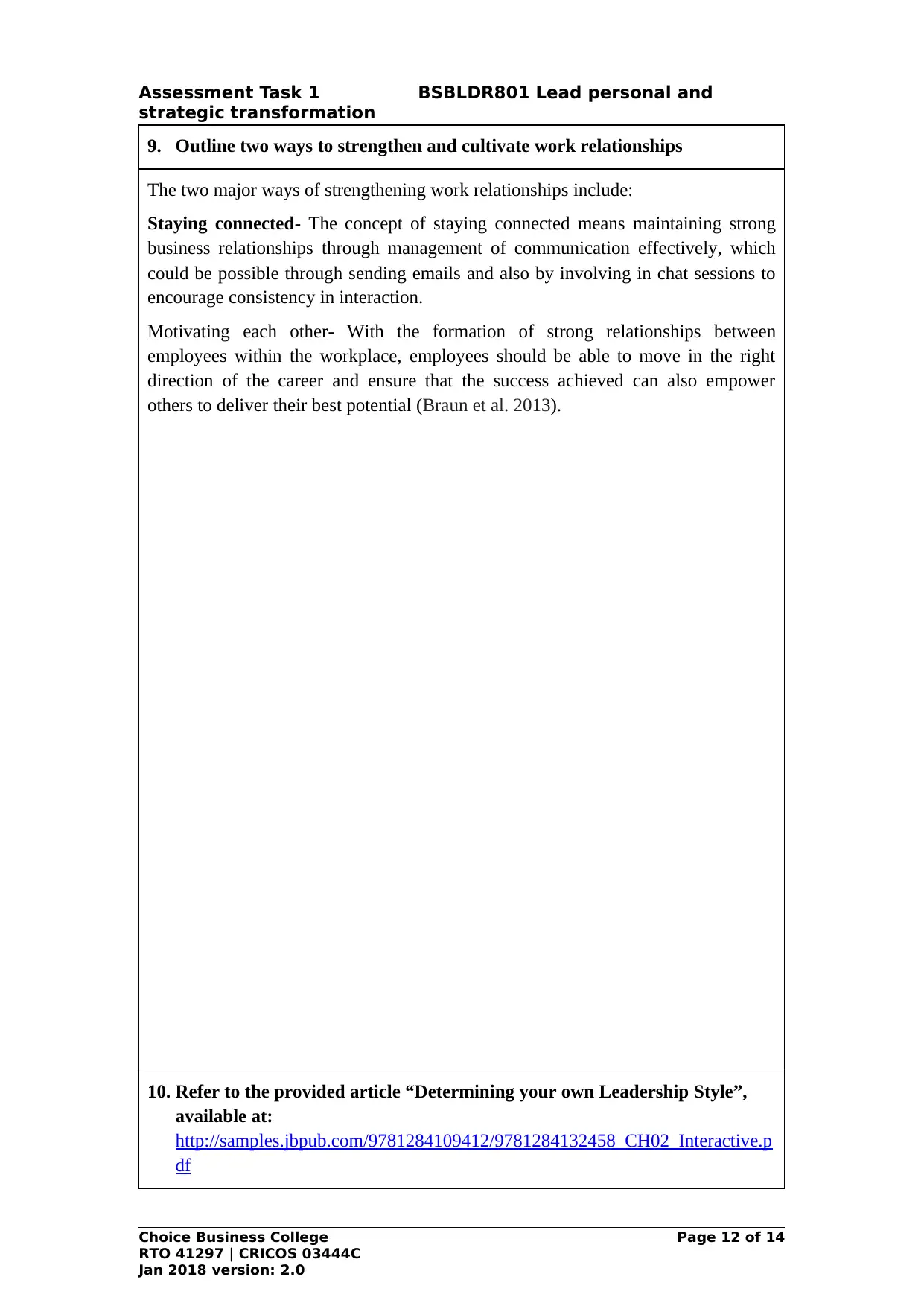
Assessment Task 1 BSBLDR801 Lead personal and
strategic transformation
9. Outline two ways to strengthen and cultivate work relationships
The two major ways of strengthening work relationships include:
Staying connected- The concept of staying connected means maintaining strong
business relationships through management of communication effectively, which
could be possible through sending emails and also by involving in chat sessions to
encourage consistency in interaction.
Motivating each other- With the formation of strong relationships between
employees within the workplace, employees should be able to move in the right
direction of the career and ensure that the success achieved can also empower
others to deliver their best potential (Braun et al. 2013).
10. Refer to the provided article “Determining your own Leadership Style”,
available at:
http://samples.jbpub.com/9781284109412/9781284132458_CH02_Interactive.p
df
Choice Business College Page 12 of 14
RTO 41297 | CRICOS 03444C
Jan 2018 version: 2.0
strategic transformation
9. Outline two ways to strengthen and cultivate work relationships
The two major ways of strengthening work relationships include:
Staying connected- The concept of staying connected means maintaining strong
business relationships through management of communication effectively, which
could be possible through sending emails and also by involving in chat sessions to
encourage consistency in interaction.
Motivating each other- With the formation of strong relationships between
employees within the workplace, employees should be able to move in the right
direction of the career and ensure that the success achieved can also empower
others to deliver their best potential (Braun et al. 2013).
10. Refer to the provided article “Determining your own Leadership Style”,
available at:
http://samples.jbpub.com/9781284109412/9781284132458_CH02_Interactive.p
df
Choice Business College Page 12 of 14
RTO 41297 | CRICOS 03444C
Jan 2018 version: 2.0
⊘ This is a preview!⊘
Do you want full access?
Subscribe today to unlock all pages.

Trusted by 1+ million students worldwide
1 out of 14
Related Documents
Your All-in-One AI-Powered Toolkit for Academic Success.
+13062052269
info@desklib.com
Available 24*7 on WhatsApp / Email
![[object Object]](/_next/static/media/star-bottom.7253800d.svg)
Unlock your academic potential
Copyright © 2020–2025 A2Z Services. All Rights Reserved. Developed and managed by ZUCOL.





